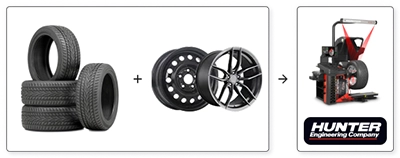Common Winter Tire Myths Debunked - Dispelling Misconceptions About Winter Tires

The arrival of winter often brings many questions about winter tires and their alternatives. However, many myths persist regarding their usefulness, performance, and necessity. Here are some common misconceptions that we will debunk.
1. Myth: All-season tires are enough to handle winter
Truth:
Although all-season tires are designed to provide acceptable performance in various weather conditions, they are not optimized for extreme winter conditions. Below 7°C, the rubber in all-season tires hardens, reducing their ability to grip the road properly. On the other hand, winter tires are made with a softer compound that remains flexible even at very low temperatures, improving grip. For example, in a braking test conducted at -10°C on an icy road, winter tires allowed a car to stop in 30 meters, whereas the same car equipped with all-season tires needed 45 meters to stop. This 15-meter difference can be crucial in preventing an accident, especially in urban areas or on a slippery highway.
2. Myth: Winter tires are unnecessary in the city
Truth:
Even in cities where roads may be cleared relatively quickly, urban winter conditions remain unpredictable. Sometimes snow melts and refreezes, forming ice patches, or snow accumulates in critical areas like intersections. Another example is sudden stops at red lights or in pedestrian zones. In these situations, winter tires can make a big difference. In fact, tests conducted on lightly snow-covered urban roads showed that vehicles equipped with winter tires stop about 20% faster than those with all-season tires. This means that even in cities, winter tires can prevent you from sliding into an intersection or hitting a pedestrian.
3. Myth: If I drive carefully, I don’t need winter tires
Truth:
Driving carefully is, of course, essential, but it cannot compensate for the absence of tires suited to winter conditions. Even at low speeds, a thin layer of ice or wet snow can make the road extremely slippery. Winter tires are specifically designed to enhance grip in these conditions, allowing drivers to maintain better control of their vehicles. Take the example of a situation where a cautious driver approaches an icy curve at 20 km/h. With all-season tires, the vehicle is likely to lose grip and start sliding. In contrast, winter tires, thanks to their additional sipes and optimized rubber, will allow the vehicle to stay stable and safely navigate the curve.
4. Myth: Winter tires are only for snowy regions
Truth:
It is common to think that winter tires are only necessary in regions where heavy snowfall is frequent. However, the reality is that winter tires are also highly effective on cold and icy roads, even when there is no snow. Their design improves traction as soon as the temperature drops below 7°C. For example, in areas like southern France or certain parts of Quebec where winters are cold but often dry, winter tires still offer greater safety. In fact, studies have shown that the performance of winter tires on dry but cold roads is significantly better than that of all-season tires, especially in terms of braking and handling.
5. Myth: All tires with the "M+S" symbol are winter tires
Truth:
The “M+S” (Mud and Snow) marking is often misunderstood as certification for winter tires. In reality, this marking simply means that the tire is designed to perform better than summer tires in muddy or slightly snowy conditions. However, it does not guarantee optimal performance on rigorous winter roads. To be truly certified as a winter tire, the tire must bear the snowflake pictogram on a three-peak mountain (3PMSF). For example, an M+S tire may provide adequate grip on wet or slightly snowy roads, but on icy roads, only genuine 3PMSF certification guarantees suitable performance.
6. Myth: Studded winter tires are always better
Truth:
Studded tires can provide superior traction on ice, but they are not necessarily better for all winter conditions. Nowadays, many non-studded winter tires use advanced rubber compounds and sophisticated tread patterns that deliver excellent performance on packed snow and ice without the need for studs. For example, if you live in a region where roads are well-maintained and regularly cleared, non-studded tires may be a better option as they are quieter and cause less damage to paved roads. Studded tires, on the other hand, are primarily recommended for areas where roads remain icy for extended periods.
7. Myth: It is more economical to keep the same tires all year round
Truth:
Keeping the same tires all year long may seem economical at first, but it can actually cost more in the long run. All-season or summer tires wear out more quickly when used in winter, leading to premature wear and loss of performance. Additionally, driving with unsuitable tires increases the risk of accidents, which could result in significant costs for repairs or even injuries. On the other hand, by investing in winter tires, you extend the life of your summer or all-season tires since they will only be used for part of the year. Furthermore, in some provinces like Quebec, insurance companies even offer discounts to drivers who install certified winter tires.
Conclusion: Don’t believe the myths!
Winter tires are a crucial element of road safety during the cold months. They are specifically designed to offer the best possible grip on snow, ice, and in cold weather. Don’t let false ideas influence your tire choices, and make sure your vehicle is equipped with tires suited to the season. For your safety, it is always recommended to equip your vehicle with winter tires as soon as temperatures start to drop.
Dominic Vaillancourt
Expert automobile & Porte-parole


